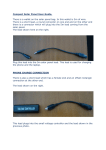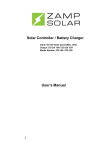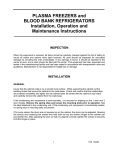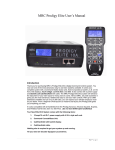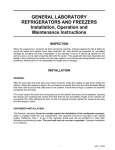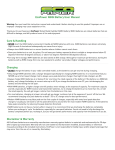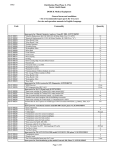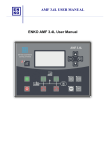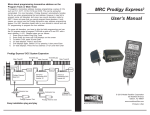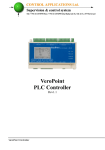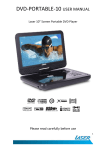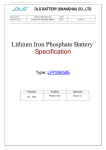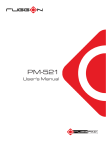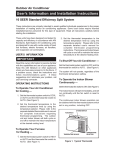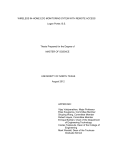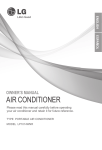Download Super Brain 977 Manual - Model Rectifier Corporation
Transcript
Super Brain 977 AC/DC Charger with Dual Output and Discharge Function User’s Manual Model Rectifier Corporation 80 Newfield Avenue Edison, NJ 08837-3817 Phone: 732-225-6360 www.modelrectifier.com Please read this entire manual, including all Safety Cautions and Warnings before operating this charger. Never leave charger unattended when in use. Adult supervision required for children under 12 years of age. SAFETY CAUTIONS & WARNINGS 1. Never leave the charger unattended when in use. 2. Do not connect the unit to the DC power supply while there is a battery attached to the unit. You should disconnect the battery first and then connect the unit to DC power supply. 3. Do not leave the battery inside any product while charging. 4. Place the charger and battery on a solid uncarpeted surface with good ventilation. 5. Do not charge the battery inside the full-size automobile as damage to interior can result. 6. Battery damage can occur if the charge current (Amps) rate is set too high. Different capacity batteries may require a higher or lower charge rate. Follow the “Notes on Charging Batteries” in addition to battery manufacturer’s instructions. 7. If the battery or the charger becomes extremely hot, immediately disconnect the charger from the power source and allow the battery and charger to cool. 8. The charger is designed to charge 1~9 cells nickel cadmium or nickel metal hydride batteries. It will also charge Lithium, lead-acid/ gel cell batteries. Because of the volatile nature of Lithium batteries, great care must be taken when charging these cells. If improperly or over charged, there is the risk that the battery will explode or catch fire. Please follow instructions/recommendations from battery manufacturer when selecting proper charge rate. 9. Discontinue use if charger casing becomes damaged or cracked. 10. Do not use the DC power source of a full-size automobile when the motor is running. 11. Always disconnect charger from the power source and any battery when not in use. 12. Adult supervision is required for ages 12 and under. 13. If at any time the cooling fan should fail, discontinue use and return for service. Thank you for purchasing MRC’s Super Brain 977 Pro charger. The 977 offers you the latest technology and many more features over the previous models, but still at a very affordable price. I. FEATURES • AC/DC Delta Peak charger with dual independent outputs • Discharge function allows you to get the most out of your batteries • Charge two batteries at the same time – even if they are different voltages and/or battery types • Charge and discharge at the same time (discharge on channel A only) • Charges NiCd, NiMH, Lithium, and Lead Acid • Large LCD screen shows: Battery Status, Battery Voltage, Charge Rate, Peak Threshold in mV, Capacity in mAh, Number of Cells in Pack, Time in Minutes • For 1~8 cells any capacity battery (NiCd & NiMH) • Selectable charge rate with 0.10 Amp increments from 0.20 Amps to 5.0 Amps • Selectable discharge rate with 0.10 Amp increments from 0.20 to 4.0 Amps • Selectable peak threshold in 5mV increments from 5 to 50 mV • Cooling fan keeps components cool for continuous charging • 12-bit Analog to Digital converter greatly improves measurement resolution • Digital Signal Processing filters out noise and provides better measurement accuracy • MRC’s patented MicroPeak technology keeps batteries cooler II. DISPLAY The in depth displays on the 977 puts a wealth of information at your fingertips. A - when lit, all functions refer to Channel A B - when lit, all functions refer to Channel B A Discharge - discharge indicator charge - charge indicator mAh - capacity indicator B Discharge mAh Stop Cell Min Amp mV Cell - cell number indicator used for NiCd and NiMH batteries only Min - time indicator Amp - current indicator V - voltage indicator Battery status mV - Delta Peak threshold indicator Solid Stop - indicates channel is idle Blinking Stop - indicates trickle charge 1 III. OPERATION A. CHARGING NICKEL CADMIUM (NICD) AND NICKEL METAL HYDRIDE (NIMH) BATTERIES ONLY Never leave charger unattended when in use. The unit has two channels and can handle two batteries at the same time. However the LCD only displays one channel at a time. 1. Always connect the power source (120V AC adapter or 12V DC) to the charger first. The AC adapter has thermal and overload protection. When the adapter is overheated or overloaded, it will cutoff its output. RB977 power supply is equipped with a tempreature controlled cooling fan. It only operates under heavy load. 2. Attach the battery to one of the outputs on the charger. The battery’s voltage will appear on the screen. If the battery voltage reading is zero, check the polarity of the battery connection. The 977 will not charge or discharge a battery having zero reading in voltage. At this point, if you are operating on channel A, you can select charge or discharge by pressing charge or discharge button. You can select charge or discharge only when the voltage is displayed during setting. 3. If you want to use both channels, you should finish both channel’s settings before starting either channel. This will make the setting process faster. Once one channel is running, the charger will only take one setting command per second for the other channel. This is slow if you are making many setting changes. 4. Select the appropriate channel/output you wish to operate by pressing the “A/B select” button. 5. The charge current can be changed by pressing the “Display Select” button to select the Amp display, and then pressing the “+” or “-” button to select the Amps setting. WARNING: Consult battery manufacturer’s instructions or included section “Notes on Charging Batteries” before selecting charge rate. 6. The 977 can determine the number of cells in the pack you are charging. This is based on the voltage and time curve of the battery when connected to the output leads. The initial cell number displayed may be incorrect. However the final cell number reading will be correct. To speed up the test procedure, you can simply input the number of cells instead of letting the 977 measure it. 7. The 977 will select a peak setting based on the number of cells in the pack (5mV per cell). While this setting may be appropriate for NiMH batteries, it may be too conservative for NiCd batteries. Press the “Display Select” button until “mV” setting appears on the screen, then press the “+” or “-” button to select the appropriate peak voltage threshold. Please refer to the “Notes on Charging Batteries” section for the appropriate settings. 2 Once the Delta Peak threshold is set manually, the charger will use this setting, even if it is not an appropriate setting for the battery. Please follow the included recommendation on peak threshold settings. Damage to the battery can occur if you are not careful. 8. The 977 also has the ability to perform a “capacity” charge. By pressing the “Display Select” button again, you will see mAh displayed with two bars. At this point you can enter the capacity to which you wish the 977 to charge by pressing + or -. Once you press + or -, the unit will take the value as capacity limit. The 977 will not charge above this capacity. However, if a peak is detected (based on the peak threshold selected) before this capacity is reached, the 977 will terminate the fast charge cycle. After the charge/discharge cycle is started, this display will show the amount of charge/discharge in mAh. If you wish to perform a normal peak charge, entering the battery’s capacity is not necessary. Only change if you wish to perform a capacity charge. 9. The 977 has the ability to perform a “timed” charge. Pressing the “Display Select” will bring you to the timer function (Min) with two bars. Here, you can predetermine the length of the charge cycle in minutes. As with the capacity charge, if a peak is detected before the selected time, the 977 will terminate the fast charge cycle. After the charge/ discharge cycle is initiated, this display will show the elapsed time of the cycle. Press the “Start” button at any time to begin charging/ discharging. If you wish to perform a normal peak charge, entering the length of charge time is not necessary. Only change if you wish to perform a timed charge. 10. Once the charging starts, you cannot change settings. If you wish to do so, please press the “Stop” button to stop the channel you are currently operating. 11. During the charge cycle, the voltage, charge rate, power status*, peak threshold setting, current amount of charge/discharge in Amp, and charge time can be viewed by pressing the “Display Select” button. * Power status is the amount of available power, out of 100, that the selected channel is currently utilizing. If power status shows 100, this is an indication that the displayed charge current is the maximum current that the charger can provide for that particular battery. This will happen when you charge 9 cells battery with 5Amp setting. The real current will be far below 5Amp. 12. Charging/discharging can be stopped at any time during the cycle by pressing the “Start/Stop” button. 13. When the fast charge/discharge cycle is complete, the unit will beep once and the word “stop” will blink on the screen. At this time, you can scroll through the displays to check the finishing values mentioned above such 3 as time (Min) and capacity (mAh). If in the charge mode, a 50-minute 50~80mA trickle charge will begin. After the trickle cycle, the charger will automatically go into sleep mode. Press the “Start/Stop” button to reset the charger. There is no trickle cycle after discharging. 14. If the battery is disconnected or a bad connection occurs at any time during the cycle or before the charger is reset, an “ERR” message will be displayed. 15. Once the “Stop” button is pressed and the channel is reset, all settings of the channel and information will be erased except for the current (Amp) setting. Notes on Charging Batteries (NiCd and NiMH) The SuperBrain 977 charger you just purchased is considered a Delta Peak Charger. You may ask, “What is Delta Peak?” or “What is Delta Peak Threshold?” Delta is a scientific way of saying, “change in”. As you charge your battery you may notice that the voltage is consistently climbing. The 977 is constantly monitoring your batteries voltage looking for a peak voltage. Every battery has a peak voltage, and when the battery reaches its peak, it will start to drop off a little, or start to lose voltage. This is what the 977 is looking for, that small amount of drop in the peak voltage. This is what tells the charger that the battery is fully charged. Peak Threshold Settings (NiCd and NiMH) While the 977 is capable of selecting the appropriate Peak Threshold, which is somewhat conservative for NiCd batteries, you can manually set the peak threshold for each battery. This is the “mV” setting on the 977. If you set a higher value, this makes the 977 less sensitive, a lower value more sensitive. If you use too high of a value, you risk over charging your battery and damage may occur. If you set too low a value, you may under charge a battery, or get “false peaks”, and it will not be charged to its full capacity. “What values should I use?” you ask. The peak threshold setting depends on the type of battery being charged, and the number of cells in that battery. For NiMH battery, you want to use a value of 5mV per cell. So for instance, when charging a 7.2-volt NiMH battery, use a value of 30mV. (7.2 volt batteries have 6 cells in them. 6 cells x 5mV = 30mV) For NiCd batteries, you can use a value of 7 to 10mV per cell. Just remember too high a value may cause overcharging and too low value may cause undercharge. Charge Rates (NiCd and NiMH) What about charge rates (amp setting)? For NiCd batteries, you can use a maximum charge rate of: capacity times 3 for sub-C or larger cells, and capacity times 2 for AA cells or smaller. For NiMh, use maximum charge rate of: capacity times 2. For example, a 1500mAh NiCd can be charged at 4.5 Amps (1500mAh x 3 = 4500mAh or 4.5 Amps) For new batteries, a lower charge rate is better. Capacity ÷ 2 would be appropriate. For example, a new 3000mAh NiMH would have an initial charge of 1.5 Amps (3000mAh ÷ 2 = 1500 mAh, or 1.5 Amps). 4 B. CHARGING LITHIUMION/POLYMER BATTERIES Never leave batteries unattended when charging. Monitor the temperature of the battery occasionally during the charge cycle. If batteries become hot or voltage exceeds 4.20 volts per cell, disconnect immediately. Lithium batteries contain explosive material. Because of the volatile nature of Lithium batteries, great care must be taken when charging these cells. If improperly or overcharged, there is the risk that the battery will explode or catch fire. Please follow instructions and/or recommendations from the battery manufacturer when selecting proper charge rate. 1. We recommend that you use a charge rate of no higher than 1C. For example, for a 1600mAh battery, the charge current should be no greater than 1.6 Amps. Read your battery’s instruction to find the right charge current. 2. You must enter the cell number of your Lithium battery pack. Enter one cell for 3.7 V battery. Enter two cells for 7.4 V battery. Enter three cells for 11.1 V battery. 3. You must plug in the battery before enter the cell number and press Start. 4. After starting the charge process, press Display Select button to make sure that the word “LiPo” appears on the “cell” screen. When charging a Lithium battery, never leave the battery unattended. Never allow the battery voltage to exceed 4.20 volts per cell. C. CHARGING 12V LEAD ACID OR GEL CELL BATTERY Never leave charger unattended when in use. We recommend using a charge rate of no higher than 0.2 times the capacity of the battery. (example for 7AH battery the charge rate = 0.2 x 7 or 1.4 Amps). D. DISCHARGING BATTERIES The 977 has a built in discharge feature in it. You can discharge your batteries on Channel A only. When discharging Lithium batteries, do not enter the cell number. Once a battery is connected to the charger and the voltage is displayed, you can select the discharge function by hitting the “Discharge” button. You can only switch between charge and discharge when the unit displays the voltage in channel A. You can then select the discharge rate you wish to use in the same way you would select the charge rate. The maximum discharge rate available is 4.00 Amps. You can then hit the “Start” button to start the discharge process. You can also discharge on Channel A while you are charging on Channel B. E. TESTING BATTERY CAPACITY You can test your battery pack’s capacity compared to the rated capacity of the pack. Simply discharge the battery first, and then charge battery using the recommended settings from above. Then, discharge your batteries using a discharge rate of: rated capacity ÷ 5. This will give you a good indication of the condition of your battery. 5 IV. OPERATIONAL FLOW CHART Press Display Press Press Press Press Press Display Display Display Dispaly Display Voltage Amp mAh mV Cell Min Press +/- to Press +/- to Press +/- to change delta change capa- change time peak setting city setting setting Press +/- to Press +/- to Press +/- to select charge change curr- change battery cell # or discharge ent setting V. MAXIMUM CURRENT The following tables show the maximum charge current & discharge current. Channel A • Charge and discharge ability for 1 to 8 cells • Charge current rate: from 0.20 to 5.0 Amps • Discharge current rate: from 0.20 to 4.0 Amps Channel A 1 cell 2 cells 3 cells 4 cells 5 cells 6 cells 7 cells 8 cells Max. Charge Current 2.0Amp 2.5Amp 3.0Amp 3.5Amp 4.0Amp 5.0Amp 5.0Amp* 5.0Amp* Max. Discharge 4.0Amp 4.0Amp 4.0Amp 4.0Amp 4.0Amp 4.0Amp 3.0Amp 2.5Amp *Note: Need higher than 12V DC input. Channel B • Charge only for 1 to 8 cells • Current rate: from 0.20 to 5.0 Amps Channel B 1 cell 2 cells 3 cells 4 cells 5 cells 6 cells 7 cells 8 cells Max. Charge Current 2.0Amp 2.5Amp 3.0Amp 3.5Amp 4.0Amp 5.0Amp 5.0Amp* 5.0Amp* *Note: Need higher than 12V DC input. VI. COOLING FAN RB977 power supply is equipped with a temperature controlled cooling fan. It only operates under heavy load. VII. SERVICE RETURN PROCEDURE If it should be necessary to return the charger for service, please include a letter (printed clearly) with your name, address, a daytime phone number, and a detailed description of the problem you are experiencing. Please include $9.00 to cover the return shipping and handling cost. MRC will not accept any charger for repair that has been modified in any way. Send to: Attn: Parts & Service, Model Rectifier Corporation 80 Newfield Avenue, Edison, NJ 08837-3817 © 2005 Model Rectifier Corporation • Printed in China








